Have you ever experienced the heartwarming sensation of a steaming bowl of homemade soup on a crisp autumn evening? There’s a special kind of magic in the combination of roasted red peppers and fresh tomatoes that signals the comforting transition from summer to fall. This Roasted Red Pepper and Tomato Soup Recipe is more than just a dish; it’s a tradition that brings warmth and flavor into our homes.
For me, this recipe represents an annual ritual where I embrace the fresh garden produce—bell peppers bursting with color and tomatoes ripened to perfection. These key ingredients come together, roasted to bring out their sweetness and depth, creating a symphony of flavors that is both hearty and comforting. The soup yields about 12 cups, making it perfect not only for immediate enjoyment but also for freezing, ensuring that you can carry a bit of that autumnal warmth with you well into the colder months.
This homemade red pepper tomato soup holds a special place in my heart, as it reminds me of family gatherings and cozy days spent indoors. Preparing and sharing this soup is my way of reconnecting with those cherished moments, and I can’t wait to share it with you.
Introduction to Roasted Red Pepper and Tomato Soup
The roasted red pepper and tomato soup is one of the best comfort foods you can create in your kitchen. This easy tomato soup recipe with roasted peppers combines the sweetness of roasted red peppers with the tangy flavor of tomatoes, creating a harmonious blend that is as delightful as it is nourishing.
Why I Love This Recipe
There are countless reasons why this is the best roasted red pepper soup I have ever made. First of all, the unique flavor profile that roasted red peppers bring to this dish is simply unparalleled. The combination of 12 medium-sized tomatoes and 2 roughly chopped red peppers, along with a large yellow onion and a whole bulb of garlic, make for an aromatic and flavorful base.
With the simplicity of preparation in mind, the recipe calls for preheating your oven to 425°F and roasting the peppers, onions, and garlic with 2 tablespoons of olive oil. The addition of 1 teaspoon of balsamic vinegar adds a touch of sweetness and depth that elevates the soup’s overall flavor.
The Comfort of Homemade Soup
Homemade soup brings a sense of warmth and comfort that store-bought versions simply cannot match. One of my favorite parts about making this easy tomato soup recipe with roasted peppers is the flexibility it provides. Whether you prefer your soup vegan or creamy, you can easily adjust the ingredients to suit your taste. For a creamy version, I recommend adding 1/2 cup of heavy cream.
The soup can be stored in the refrigerator for up to 4 days or frozen for up to 3 months. This makes it a perfect meal prep option for busy weeks or to save for a rainy day when you need a quick, comforting meal.
In addition, the nutritional benefits of this best roasted red pepper soup are significant. Each serving delivers 309 kcal, with a well-balanced profile of fats, proteins, and carbohydrates, making it both a heartwarming and healthy choice.
Ingredients You’ll Need
Diverse, fresh ingredients can make a world of difference in our delicious tomato and red pepper soup. With a delightful balance of flavors and textures, selecting the best ingredients is essential for superior results.
Fresh vs. Canned Ingredients
When it comes to preparing this delightful soup, fresh ingredients for roasted red pepper and tomato soup are always my first choice. Fresh tomatoes and red peppers lend a vibrant flavor unmatched by canned varieties. However, for times when convenience trumps all, canned tomatoes can be a great substitute without compromising too much on the taste.
Choosing the Right Peppers
The flavor of red peppers is crucial to achieving the characteristic robust and sweet notes of the soup. Opt for the freshest red bell peppers available; their sweetness beautifully complements the acidity of the tomatoes. Roasting the peppers enhances their natural sugars, creating a depth of flavor that is hard to beat.
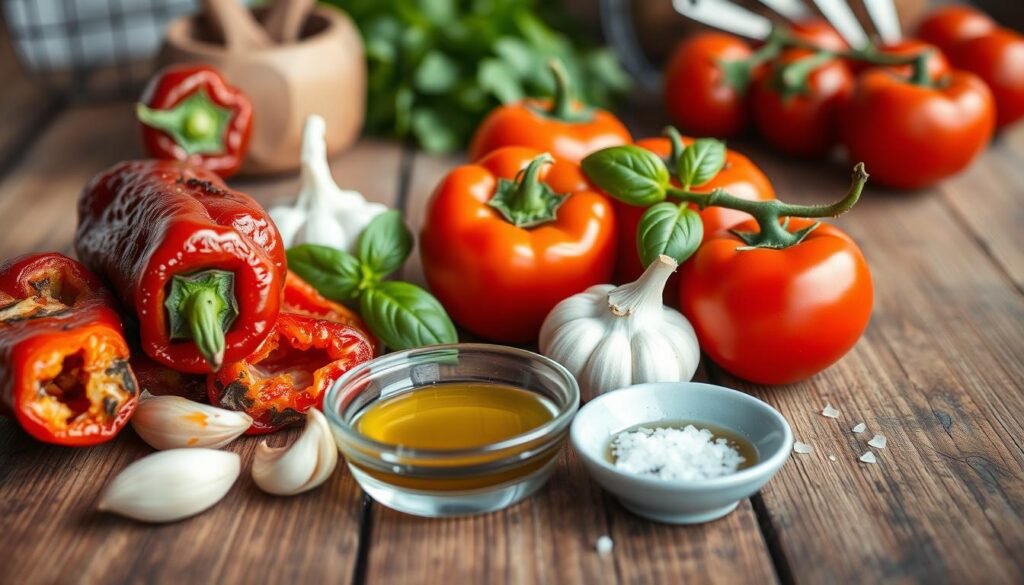
Optional Toppings and Additions
Customizing your delicious tomato and red pepper soup with optional toppings and additions can transform it into a personalized culinary experience. Consider adding a dollop of cream or sour cream for a rich, velvety texture. For a vegan twist, coconut milk or a splash of almond cream works wonders. Fresh herbs like basil or parsley, a sprinkle of cheese, or even a swirl of pesto can elevate the flavor profile, making each bowl unique and flavorful.
Preparing the Ingredients
Learning how to make roasted red pepper and tomato soup starts with meticulous preparation of each ingredient. Each step, from roasting to sautéing, plays a crucial role in developing the rich flavors that culminate in a delightful bowl of soup.
Roasting the Red Peppers
To bring out the natural sweetness and slight smokiness, I begin by roasting my red bell peppers. For this recipe, I use 3 large red bell peppers, which yield approximately 2 cups when roasted. The peppers should be roasted until their skins are charred, making them easy to peel and imparting a delicious depth of flavor to the soup.
Chopping and Sautéing the Aromatics
Once the peppers are roasted and set aside, the next step is chopping and sautéing the aromatics. I use aromatic onions and garlic, sautéed until they are soft and fragrant. This foundational base is crucial for a well-rounded roasted red pepper tomato bisque. It’s essential to take your time with this step, allowing the onions and garlic to develop their full flavors.
Preparing the Tomatoes
Lastly, preparing the tomatoes is an important step in how to make roasted red pepper and tomato soup. I prefer using 2 pounds of medium cocktail tomatoes, although 2 cups of roasted tomato sauce can be an excellent alternative. Roasting the tomatoes further enhances their natural sweetness, creating a perfect harmony with the roasted red peppers.
For more detailed instructions and specific cooking tips, you can refer to this roasted red pepper tomato bisque recipe. By diligently preparing each ingredient, you ensure that every spoonful of soup is rich, flavorful, and satisfying.
Cooking Process Explained
The journey to creating a flavorful creamy tomato and red pepper soup begins with combining all your roasted ingredients into one pot. This crucial step ensures an even distribution of flavors, which is essential when making roasted red pepper and tomato soup from scratch.
Combining Ingredients in the Pot
Once the roasting is complete, gather the roasted red peppers, tomatoes, garlic, and onions, and place them into a large pot. This is also the time to add vegetable stock, which brings a rich base to the soup. Ensuring all elements are in one pot allows the flavors to meld beautifully.
The Importance of Simmering
Simmering is key in this process. Once you’ve combined all the ingredients, bring the mixture to a gentle simmer over medium heat. Simmering for 15-20 minutes lets the flavors intensify and blend together, providing a depth that’s crucial for a well-rounded creamy tomato and red pepper soup.
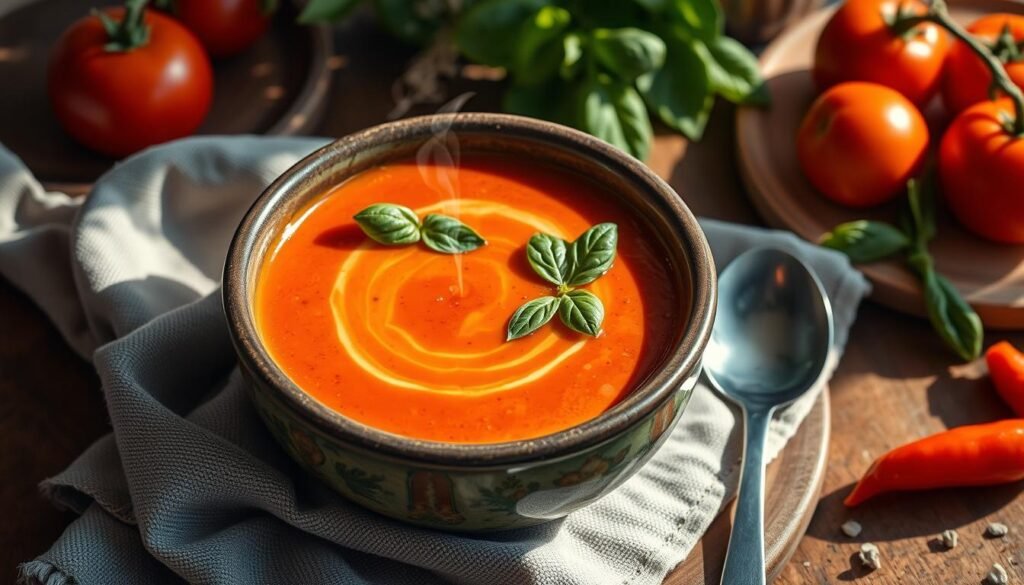
Blending for the Perfect Texture
Achieving the perfect texture is the final step in making roasted red pepper and tomato soup from scratch. Use an immersion blender to puree the mixture directly in the pot until smooth, or carefully transfer batches to a countertop blender. Blending thoroughly creates a silky-smooth consistency, making the soup incredibly indulgent.
Following these steps will lead you to a mouthwatering soup that can be enjoyed hot or cold, embodying the essence of homemade comfort food.
Flavor Enhancements
Enhancing the flavor of your roasted red pepper and tomato soup is a crucial step in elevating its taste from good to unforgettable. The addition of spices and herbs can transform a basic recipe into a delightful culinary experience.
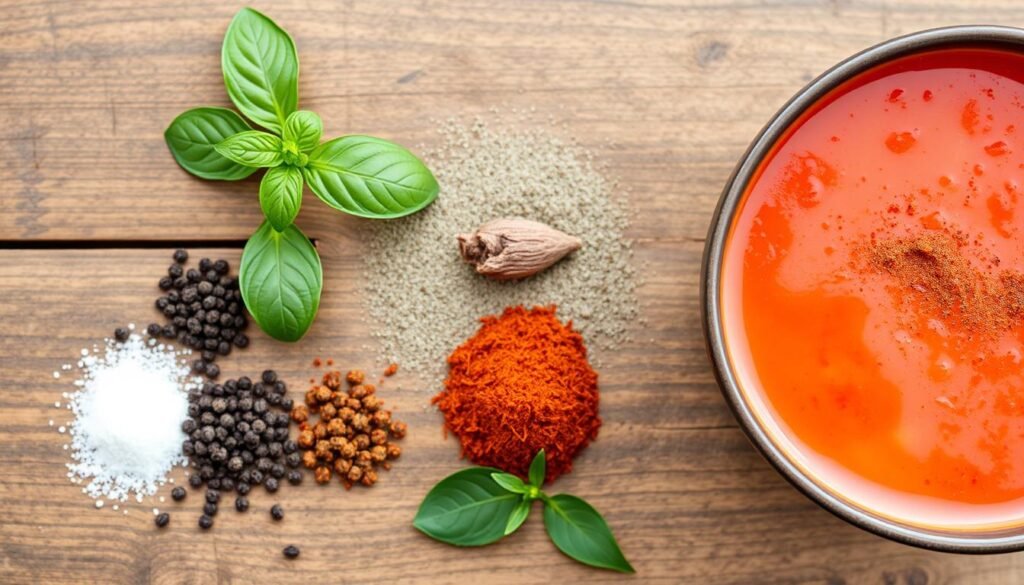
Seasoning Suggestions
When considering the best seasoning for tomato soup, smoked paprika and cayenne pepper are two excellent choices. These spices add a subtle heat and depth of flavor that complements the natural sweetness of roasted red peppers. I also recommend black pepper and sea salt as essential seasonings. A pinch of red pepper flakes can be included for an added kick, ensuring that your soup is both savory and exciting.
Adding Herbs for Depth
Fresh herbs can significantly enhance the flavor profile of your soup. Basil, in particular, works wonders by bringing a refreshing and aromatic element to the dish. Adding a cup of packed fresh basil leaves, blended into the soup, can offer a more vibrant and herbaceous taste. For additional complexity, consider incorporating fresh parsley or thyme.
Spice It Up: Optional Heat
If you’re wondering how to spice up red pepper soup, consider adding additional heat elements. A teaspoon of chili powder or a dash of hot sauce can provide a gratifying zing. For those who enjoy a spicier soup, including a pinch of additional cayenne pepper or a splash of tabasco sauce will cater to your palate’s desire for heat.
My Favorite Variations
Exploring different variations of the classic roasted red pepper and tomato soup can add excitement and cater to various dietary preferences. From creamy versions to vegan alternatives and the use of alternative vegetables, these adaptations ensure everyone can enjoy this comforting dish.
Creamy Versions: Adding Dairy
If you love a rich and creamy soup, adding dairy is the way to go. Incorporate 1/2 cup of heavy cream or 1/3 cup of grated Parmesan cheese into the soup for a luscious texture and depth. These additions blend seamlessly with the canned tomatoes and roasted red peppers, enhancing the savory notes while providing a velvety finish.
Vegan Alternatives
For those following a vegan diet, there are plenty of alternative ingredients for tomato soup to maintain its creaminess. Swap heavy cream with coconut milk or cashew cream. These vegan alternatives retain the soup’s indulgent feel without compromising on flavor. Incorporating a cup of lower-sodium vegetable broth instead of chicken broth also ensures a vegan-friendly base.

Using Alternative Vegetables
Introducing other vegetables can add new layers of flavor and make the soup more nutritious. Consider adding diced carrots or butternut squash to the mix. These alternative ingredients for tomato soup not only offer a sweeter taste but also contribute to the soup’s overall texture and nutritional profile. The addition of these vegetables beautifully complements the natural sweetness of the roasted red peppers and tomatoes.
Storing the Soup
Preserving the deliciousness of your Roasted Red Pepper and Tomato Soup requires proper techniques. Cooling, storing, and reheating are essential steps to ensure your soup remains flavorful and fresh.
Cool Down Tips
After cooking, let the soup cool down gradually. A good practice is to allow it to sit at room temperature for about 15-20 minutes before transferring it to the refrigerator. This step prevents the soup from entering the danger zone temperatures where bacteria can grow. Additionally, ensuring the soup is evenly cooled aids in better storing homemade soup effectively.
Best Practices for Freezing
Knowing how to freeze red pepper tomato soup can extend its shelf life up to three months. Use airtight containers or heavy-duty freezer bags, leaving some space at the top as the soup will expand when frozen. Label each container with the date to keep track of its storage time. Frozen in this way, your soup will maintain its rich flavor and creamy texture even after extended storage.

Reheating Properly
When reheating, gentle warming is key to preserving the soup’s quality. Avoid boiling; instead, heat the soup slowly over medium-low heat, stirring occasionally. This method helps retain the soup’s original texture and flavor. If the soup seems too thick after reheating, you can add a splash of water or stock to achieve the desired consistency. These steps ensure that storing homemade soup leads to a delicious meal every time.
Serving Suggestions
Serving roasted red pepper and tomato soup can truly elevate your dining experience, especially when you know how to pair it perfectly. Here are some of my favorite ideas to create a delightful meal.
How to Pair with Bread
The comforting essence of this soup is best highlighted when paired with the right type of bread. A classic choice is the grilled cheese sandwich, which melts wonderfully into the hearty flavors of the soup. For a lighter crunch, consider homemade croutons made from freshly baked bread, seasoned with olive oil and herbs. Flaky honey buttermilk biscuits or honey butter cornbread drop biscuits are also excellent options that complement the sweetness of the roasted red pepper and tomato soup.
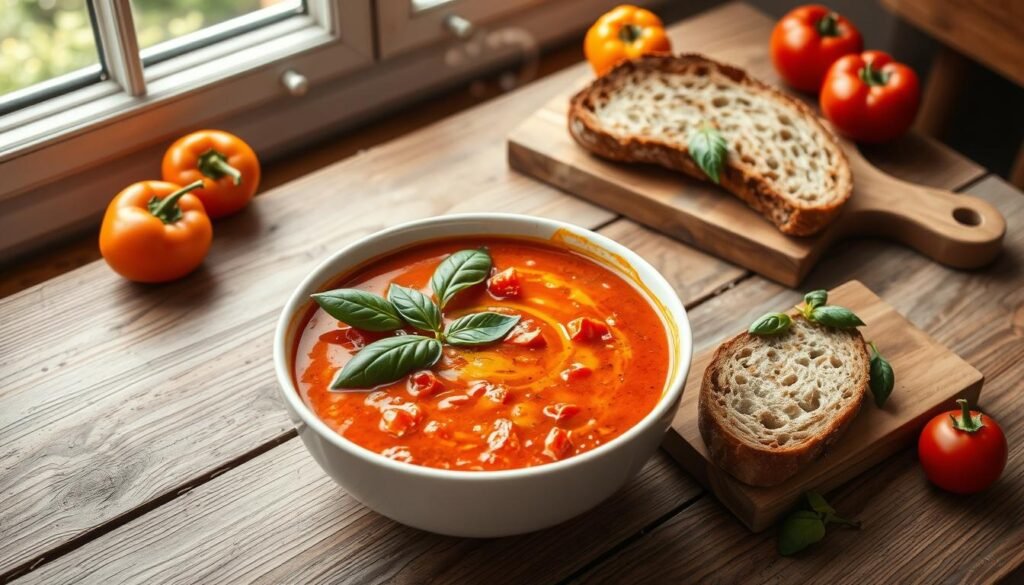
Ideal Side Dishes
To make the meal even more enjoyable, consider pairing the soup with simple yet delicious sides. A fresh green salad with a zesty vinaigrette can provide a refreshing contrast to the rich flavors of the soup. If you’re in the mood for something more substantial, roasted vegetables or a light pasta salad can be wonderful accompaniments. Quesadillas with a bit of melted cheese can also add a comforting touch.
Making It a Complete Meal
To create a complete meal around serving roasted red pepper and tomato soup, you can incorporate a few additional elements. Add a dollop of sour cream and a sprinkle of fresh herbs like basil or parsley on top of the soup for an elevated presentation. A side of avocado toast offers a nutritious, creamy contrast, making it one of the favorite complete meal soup ideas. Don’t forget to have some extra bread or biscuits on hand to soak up every bit of this delicious soup!
Nutritional Benefits
The Roasted Red Pepper and Tomato Soup is not just a flavorful addition to your meal plan; it’s also packed with incredible nutritional advantages that support a balanced diet. This nutrient-rich soup combines the health benefits of homemade tomato soup and the impressive nutritional value of red pepper soup.
Health Benefits of Tomatoes
Tomatoes are a cornerstone of this recipe, bringing a wealth of health benefits to your bowl. With approximately 95% water content, tomatoes are incredibly hydrating and contain small amounts of fiber, making them a perfect low-calorie ingredient. San Marzano tomatoes, often used in gourmet tomato soups, boast Protected Designation of Origin status in Italy, ensuring their premium quality. Just one tomato can provide 40% of your daily recommended vitamin C intake, alongside other nutrients like potassium, folate, and vitamin K.
Benefits of Red Peppers
Red peppers enhance the nutritional value of red pepper soup. More than just a vibrant color, these peppers deliver an abundance of vitamin C—over 200% of your daily requirement from just half a cup. This vegetable also provides dietary fiber, complex carbohydrates, and healthy fats, making it a comprehensive addition to any diet. The robust profile of red peppers, along with their antioxidant properties, supports various health benefits, including immune boosting and anti-inflammatory effects.
Balancing Calories and Nutrients
Balancing the calories and nutrients in your diet is crucial for maintaining overall health. Each serving of this roasted red pepper and tomato soup contains around 270 kcal, making it a nutritious yet satisfying choice. With 189 calories, 12 grams of fat, 19 grams of carbohydrates, and 5 grams each of fiber and protein per serving, it offers a well-rounded balance of macronutrients. Additionally, incorporating ingredients like garlic, onions, and black pepper can amplify the soup’s healthful properties. For instance, garlic has been known to help lower cholesterol levels, and onions are rich in organosulfur compounds, which are powerful antioxidants.
To gain more insights into the complete recipe and its health benefits, feel free to check out the detailed instructions available here.

Common Mistakes to Avoid
Creating a perfect roasted red pepper and tomato soup can be a delightful process, but it’s essential to sidestep some common soup making mistakes. Let’s dive into the key errors to avoid to ensure your soup turns out perfect every time.
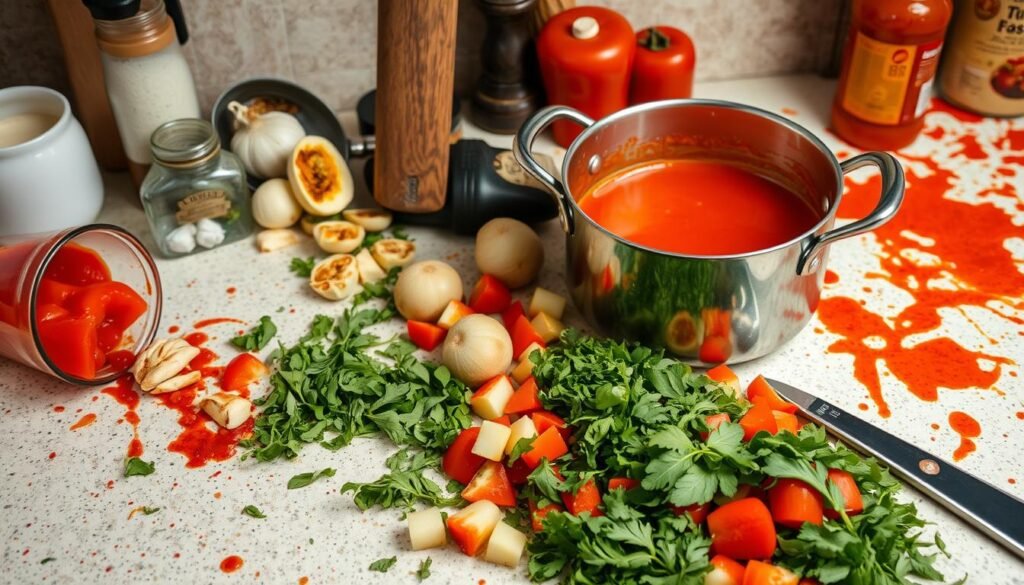
Overcooking Your Vegetables
One of the common soup making mistakes is overcooking the vegetables. When you let them cook for too long, they lose their vibrant flavors and textures, which can significantly affect the overall taste. To avoid this, keep an eye on the cooking time and make sure the veggies stay tender but not mushy. Remember, the total cook time for this recipe is just 50 minutes.
Skipping the Roasting Process
Roasting the red peppers is a crucial step that should not be skipped. This process helps develop a deep, rich flavor that’s essential for a delicious soup. The tips for perfect roasted soup start with preheating your oven and letting the peppers caramelize nicely. This extra step might add a bit of prep time, but the payoff in taste is well worth it.
Not Adjusting Seasoning
Another key aspect of making the perfect soup is constantly tasting and adjusting the seasoning. One of the tips for perfect roasted soup is to regularly taste your soup during the cooking process. Adjust salt, pepper, and any other spices to suit your preference. Remember, flavors can intensify as the soup simmers, so keep tweaking until you reach that perfect balance.
Frequently Asked Questions
Understanding the nuances of FAQ roasted red pepper soup can greatly enhance your cooking experience. Here, I’ve addressed some of the most common inquiries regarding alternatives, storage, and slow cooker adaptations.
Can I Use Different Types of Peppers?
Yes, different types of sweet peppers can be used in this recipe. While red bell peppers are recommended for their rich flavor and vibrant color, you can use orange or yellow bell peppers for a slightly different taste. Regardless of the type, ensure the peppers are roasted properly to achieve that smoky, rich flavor we all love in roasted red pepper and tomato soup.
How Long Can I Store the Soup?
Proper storage is key to maintaining the flavor and nutritional benefits of the soup. When stored in an airtight container, the soup can be kept in the refrigerator for 3-4 days. For longer storage, it can be frozen for up to three months. Remember to cool the soup completely before refrigerating or freezing to avoid compromising its integrity.
Can I Make This in a Slow Cooker?
Absolutely! This recipe is easily adaptable for slow cooker tomato and red pepper soup. Combine all the ingredients in your slow cooker and set it to low for 6-8 hours or high for 3-4 hours. This method offers convenience while still achieving rich, deep flavors, similar to the stovetop version. You can find some helpful tips and other soup recipes at the Recipe Inquirer, where detailed instructions for slow-cooking techniques are available.
For those looking to make this recipe even easier, jarred roasted peppers can be used. Just rinse them thoroughly to remove excess brine. Enjoy making this versatile and delicious soup in whatever way suits your lifestyle best!
Conclusion
Creating this roasted red pepper and tomato soup isn’t just a culinary activity for me; it’s a heartwarming experience. The blend of fresh, nutritious ingredients and aromatic seasonings offers not just nourishment but a real sense of comfort and connection. There’s nothing quite like the satisfaction derived from homemade soup recipe sharing, especially one that’s capable of evoking such rich flavors and wholesome goodness.
My Passion for Cooking This Soup
My passion for this soup stems from its sheer versatility and delightful taste. Whether adhering to a low-carb or gluten-free diet, the soup caters to those dietary needs without compromising on flavor. With only 8 grams of net carbs per serving, it’s a perfect fit for carb-conscious individuals. Moreover, the recipe is vegetarian, providing a hearty meal option for meat-free diets. The emphasis on easily accessible ingredients also makes it a go-to recipe that even culinary novices can embrace with confidence.
Final Thoughts on Sharing the Recipe
I am thrilled to share this recipe, recognizing it as more than just a dish; it represents a bridge to shared experiences and cherished moments. By embracing the homemade soup recipe sharing ethos, we can collectively appreciate why cook roasted red pepper tomato soup remains a staple in so many kitchens. It’s not merely about the delightful end product but the process of preparing, tasting, and savoring a bowl of homemade soup that brings us closer. As you enjoy this delicious and richly flavored soup, know that you are partaking in a culinary tradition that celebrates health, comfort, and community.
